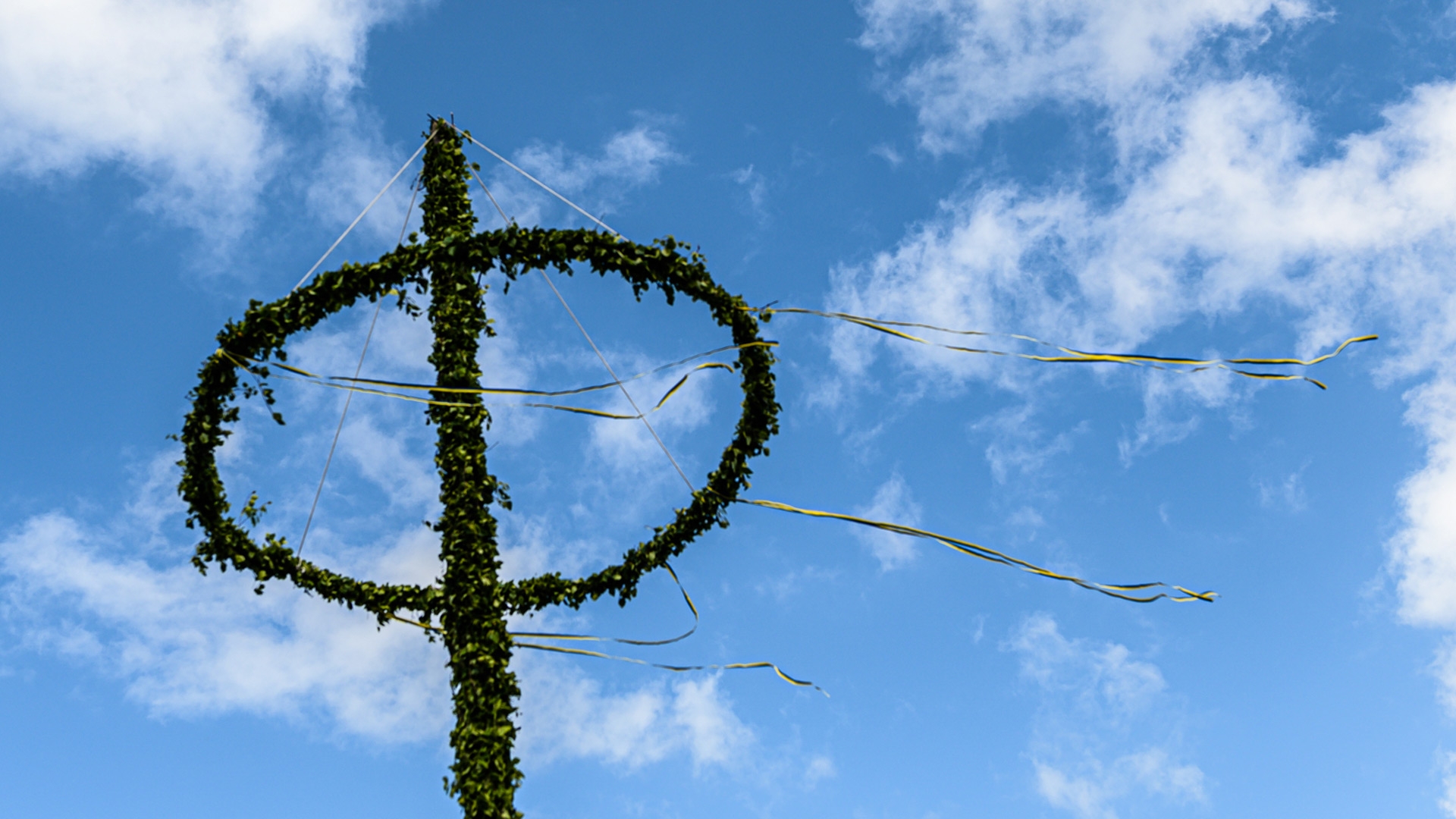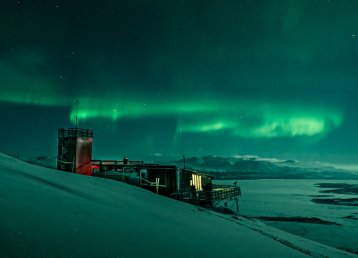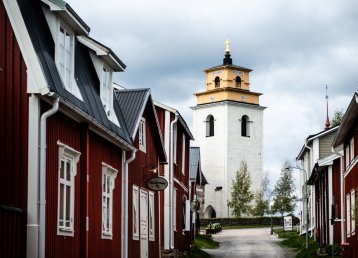The summer solstice is the longest day of the year and the sun reaches its highest position in the sky. This is when we celebrate Midsummer’s Eve, every year sometime between the 19th and the 25th of June. Above the Arctic Circle, where the sun never sets, Midsummer’s Eve is celebrated all day and all night under the light of the midnight sun.
The maypole and the wreaths
Midsummer often marks the beginning of summer. Many choose to take their holidays around midsummer. Family and friends, old and young, all gather to celebrate. Perhaps on the family farm that has been inherited through generations, perhaps in an apartment in town, perhaps at the folk museum. No matter where we celebrate there are some obligatory accessories: the maypole and the wreaths are two of them. The Midsummer maypole is like a cross – preferably several metres high – covered in leaves. We pick flowers and leaves and bind them into wreaths to decorate the pole and finish it off with ribbons in the colours of the Swedish flag.
"Our bodies are brimming with excitement and we have the entire summer in front of us"
We also bind wreaths of leaves and flowers to adorn ourselves, and perhaps a traditional costume is dusted off in honour of the day. The folk costumes symbolise our origin and history with their beautiful colours and are shown off in all their splendour at this summer highlight.
The tradition of the maypole in Sweden actually originates from Germany and can be found all over Europe in various shapes, but according to Swedish tradition, it’s shaped like a cross with wreaths hanging off either side.
Also read
13 ways of loving the midnight light“Små grodorna” (The Little Frogs)
Our bodies are brimming with excitement and we have the entire summer in front of us, so it’s not surprising that we feel a need to sing and dance. Don’t worry if what comes next confuses you a bit, because not many Swedes understand why this is the song we choose for dancing around the Midsummer maypole, but tradition says so, so we do it.
“The little frogs, the little frogs, are fun to watch.
The little frogs, the little frogs, are fun to watch.
No ears, no ears, no tails do they possess…”
We crouch down and jump like frogs, waving our hands around our heads and behind our backs to indicate the lack of ears and tails. Don’t try to work out what the connection is to the summer solstice. We have no idea, but it’s a fun song and dance and that’s good enough, right?
How “The Little Frogs” ended up in Sweden is unclear, but the melody of the song is believed to be a French marching song with the lyrics: Au pas, camarade, au pas camarade / au pas, au pas, au pas! (Keep to the beat comrades). The song was then rewritten by the eternal enemies of the French, the British, with the lyrics “Au pas grenouilles!” (“Keep to the beat, little frogs!”). How it ended up in Sweden and became one of our most famous children’s songs remains a mystery.
Herring and schnapps
Dancing and jumping like little frogs is bound to make you hungry, which means it’s time to put the midsummer food on the table. If the weather is nice, it’s to be enjoyed outside. North of the Arctic Circle it might, of course, be snowing on Midsummer Eve. But if the summer is to be celebrated, so be it.
"Some of the legends and myths surrounding Midsummer's Eve are still very much present"
On the table, we find boiled fresh potatoes, pickled herring with the classic trimmings, herring salad, salmon and fresh vegetables. The aroma of barbecues on lit fires fill in the air and we like to keep eating all day from the smorgasbord of festive food provided. As the icing on the cake, there’s the cake itself, with whipped cream and fresh strawberries, adorned with little Swedish paper flags.
Many may be familiar with the Swedish “schnapps”. A small glass with spiced liquor preceded by a “schnapps song”. They are served with the midsummer food to the tune of these schnapps songs with humorous lyrics that attract group singing and laughter.
Also read
The taste of Swedish LaplandLegends and mythology
As the evening mists settle over meadows and forests, the feeling under the light of the midnight sun is close to magic. Some of the legends and myths surrounding Midsummer’s Eve are still very much present. According to ancient folklore, plants were thought to have magical properties during the midsummer night. That’s why you should pick seven kinds of flowers and put them under your pillow to dream of your future love. You have to be completely silent as you pick them, otherwise, you break the magic.
The midsummer wreaths weren’t just worn because they are pretty, but also because the flowers were said to be invigorating. The flowers were saved until the Christmas bath, to keep you healthy and strong throughout the winter.
Celebrate Midsummer in Swedish Lapland!
Every year midsummer celebrations are organised for the public at folk museums all around Swedish Lapland. Most rural towns and villages have these museums where older buildings are preserved and this is where celebrations are held with young and old coming together to eat well, dance around the midsummer pole and enjoy local entertainment, games and folk music. Among these beautiful old buildings, you get a real experience of Swedish summer tradition at its best.
Midsummer celebrations in Swedish Lapland
In the mountains
Celebrate midsummer in the mountains with a herring lunch, a pentathlon and the world’s largest strawberry cake in Saltoluokta. This is a celebration for the whole family at the mountain station, where you get to help pick flowers for the midsummer pole, dance and enjoy a proper midsummer buffet. On Midsummer’s Eve, you can join the Midsummer’s Prayer in the church hut, and the evening is rounded off with musical entertainment.
Visit swedishtouristassociation.com for more information.
With Sámi elements
Ájtte – the Swedish Mountain and Sámi Museum in Jokkmokk – organises a midsummer celebration with Sámi elements every year. The midsummer pole is erected in the mountain botanical garden, a few hundred meters from the museum – well worth a visit even outside of the midsummer celebration – and a traditional log race is held in the bubbling mill brook.
Visit ajtte.com for more information.
In a world heritage
Next to World Heritage Gammelstad Church Town in Luleå, you will find Hägnan, an open-air museum and a cultural-historical centre of knowledge that conveys the coastal area’s cultural heritage Norrbotten county. Every year midsummer is celebrated here the traditional way, with wreath binding, a midsummer pole, games and folk music. Apart from participating in the celebration, there is a lot to see in this World Heritage and in the general store you can find local crafts, among other things.
Visit visitgammelstad.se for more information.
On the riverbank
In Kukkola, in the Torne Valley, a riparian midsummer is celebrated with the powerful Kukkola rapids as a backdrop. A traditional midsummer celebration with dancing, games, competitions and entertainment for the entire family – and a midsummer buffet, of course. If you are visiting the Kukkola rapids, the Sauna Museum is a must-see.
Visit kukkolaforsen.se for more information.
On skis under the midnight sun
In Riksgränsen, you can experience a somewhat different midsummer celebration. The slopes remain open until midsummer in Riksgränsen provided that there is enough snow. It might be difficult to find the traditional seven kinds of flowers to put under your pillow at night, but you can ski under the midnight sun.
Visit riksgransen.se for more information.
With the locals
In many villages and towns, homestead farms have been preserved as open-air folklore museums with cultural buildings and environments. Often smaller midsummer celebrations are organised here, open to the public. It is a great opportunity to get closer to the regional culture and meet the locals. The local tourist offices can provide more information about events in the town you are visiting.

























